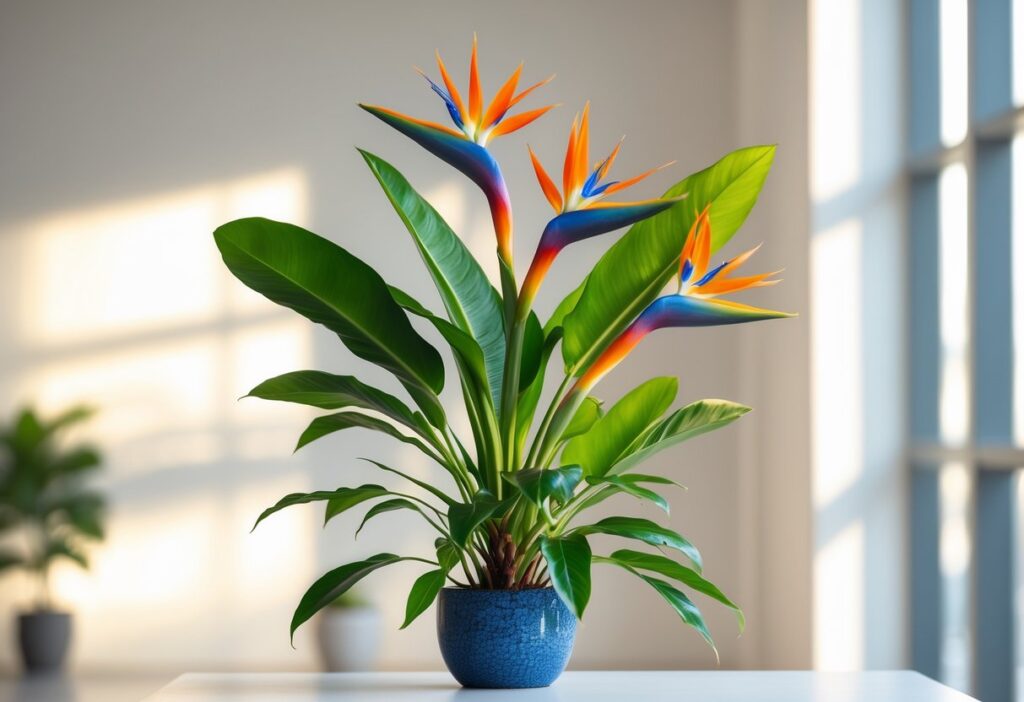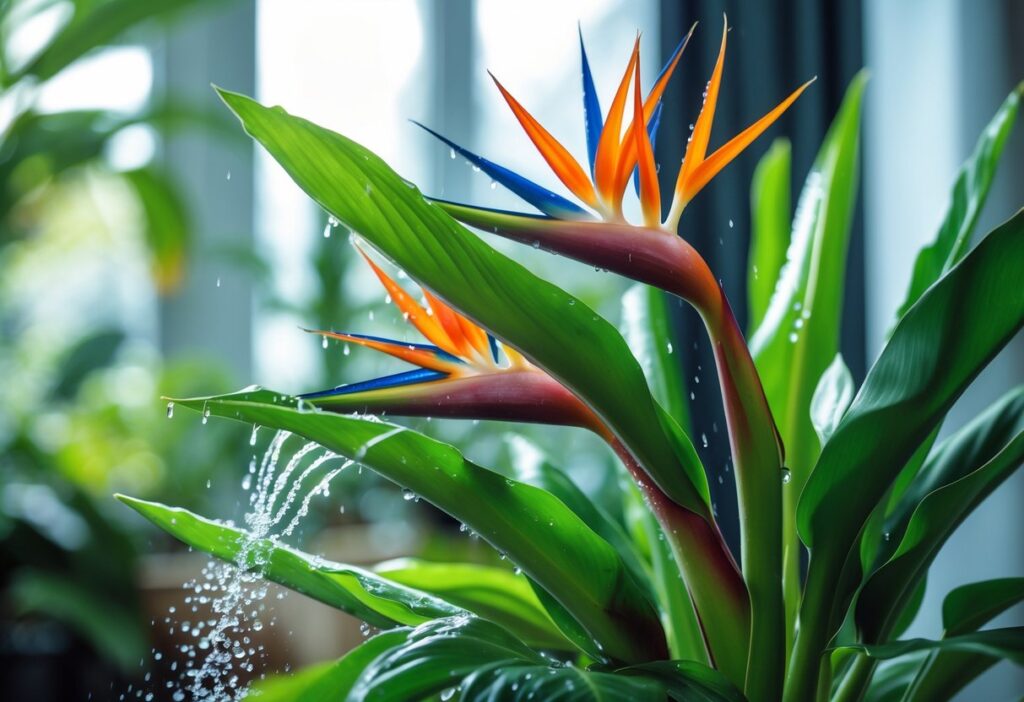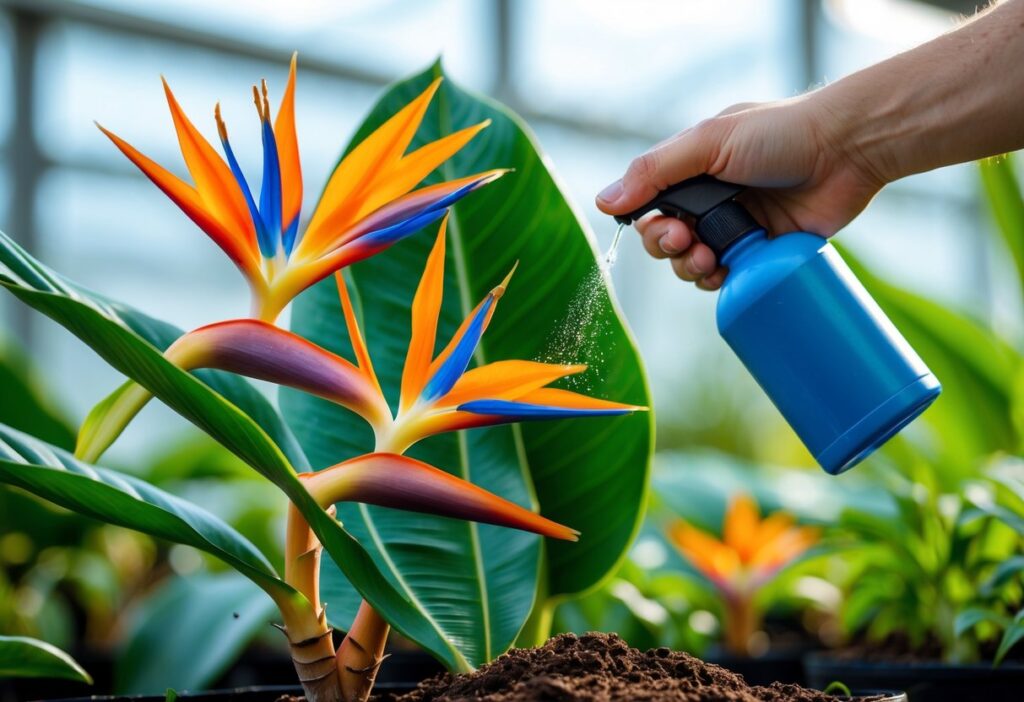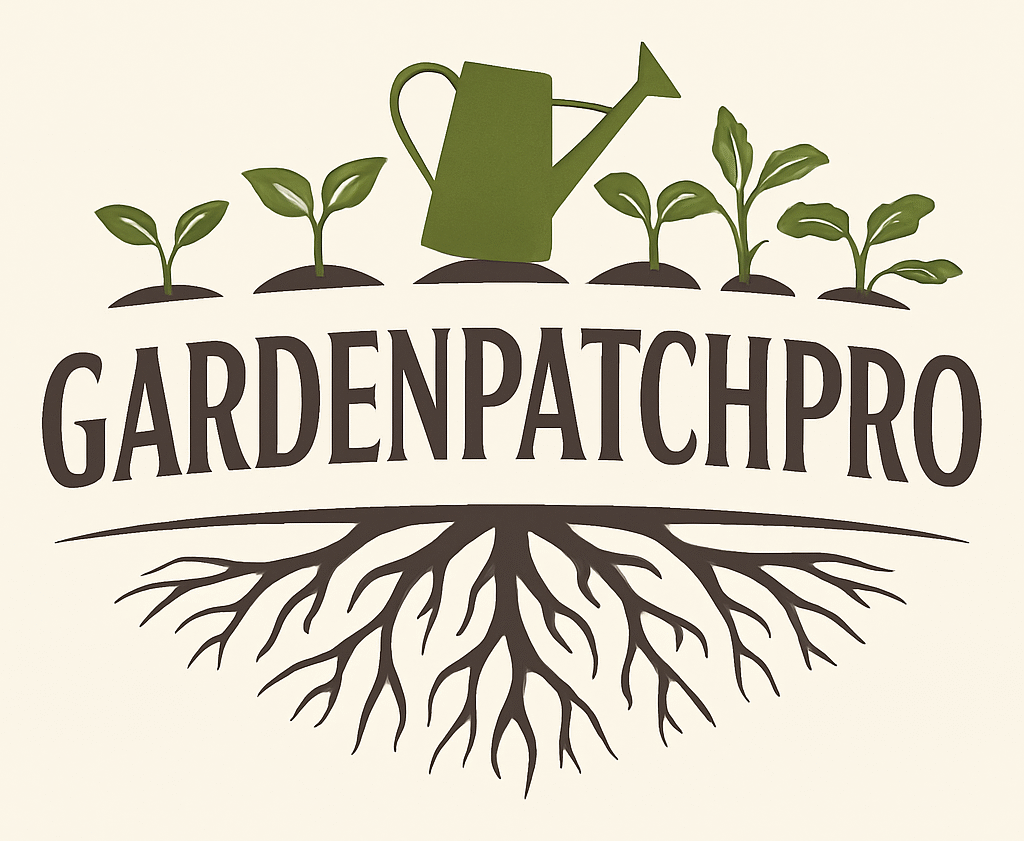Bird of Paradise Plant: Complete Care Guide & Expert Tips
The bird of paradise plant is a stunning tropical houseplant known for its bright, exotic flowers that look like a bird in flight. It thrives best with bright, indirect sunlight, regular watering, and well-draining soil, making it a rewarding yet manageable plant for both beginners and experienced gardeners. Its large leaves and vibrant blooms can bring a touch of the tropics to any home or garden.

This plant grows quickly and can reach several feet tall, but it needs the right care to bloom, including enough light and proper feeding during the growing season. It is also important to manage watering carefully to avoid root rot while keeping the humidity high enough for healthy growth. With the right environment, the bird of paradise can flower in late winter or early spring, adding dramatic color to indoor spaces.
Keeping pests and diseases under control is not difficult if the plant’s needs are met. Dividing mature plants and occasional pruning help maintain its shape and encourage new growth. Understanding these key care tips will ensure the bird of paradise remains healthy and vibrant year-round.
Key Takeways
- Bright indirect light and good soil drainage are essential for growth.
- Regular watering and feeding support healthy leaves and blooms.
- Pruning and pest control help keep the plant thriving.
Understanding the Bird of Paradise Plant

The bird of paradise plant is a distinctive tropical species known for its unique flowers and large, banana-like leaves. It is part of a small group of plants under the Strelitzia genus, native to southern Africa. Its structure and growth habits make it popular as both a houseplant and an outdoor ornamental in warm climates.
Key Characteristics
Bird of paradise plants grow upright with long, stiff leaves that resemble those of banana plants. Leaves typically measure 12 to 18 inches in length and often develop splits over time. The plant does not have a woody trunk; instead, leaves emerge directly from the soil in a fan-like arrangement.
Flowers are vivid and shaped like a bird in flight, usually orange with blue or white highlights depending on the species. They bloom mainly in late winter to early spring. The plant can reach heights of 3.5 to 6 feet and spreads about 3 to 4 feet wide.
Bird of paradise plants need bright light and well-draining soil. They tolerate full sun to partial shade but prefer protection from harsh midday sun to avoid leaf burn. The plant is toxic to pets, so caution is needed in pet-friendly homes.
Strelitzia Genus and Species
The Strelitzia genus includes five main species, but only a few are commonly grown indoors. Strelitzia reginae is the most popular and features vibrant orange and blue flowers, often called the orange bird of paradise. Another common type is Strelitzia nicolai, the white bird of paradise, which has larger white flowers and can grow taller.
Other species like Strelitzia juncea have leafless, reed-like stems, while Strelitzia caudata is rare and found in higher South African elevations. The genus is part of the Strelitziaceae family, related closely to tropical banana plants.
Typically, these species are perennial and thrive in USDA hardiness zones 10 to 12. They require warm temperatures and consistent care to flourish.
Tropical Origins and Botanical Details
Bird of paradise plants originate from South Africa, where they grow in warm, tropical to subtropical environments. Their natural habitat includes forests and riverbanks, contributing to their preference for rich, well-drained soil and high humidity.
Botanically, these plants are herbaceous perennials. Unlike trees, they do not develop a sturdy trunk but rely on thick rhizomes underground. This root structure allows them to spread and grow new shoots.
The large leaves help the plant capture sunlight efficiently, and the splits in mature leaves reduce wind damage. Their striking flowers are adapted to attract birds for pollination, resembling exotic tropical birds in appearance, which gives the plant its common name.
More detailed care and growth information about the bird of paradise plant can be found at The Spruce’s Bird of Paradise Guide.
Light and Placement

The bird of paradise needs careful attention to light and location to grow well. It requires bright conditions but can be sensitive to intense, direct sunlight. Proper placement, whether indoors or outdoors, affects its health and blooming.
Optimal Sunlight Requirements
The bird of paradise thrives with at least 5 to 6 hours of bright, indirect sunlight daily. This amount supports vigorous growth and flowers. Too little light causes yellow leaves and weak, leggy growth.
Direct sunlight during morning hours is best, especially from east or south-facing windows. However, harsh midday sun can scorch the leaves, which show brown tips or patches. Using sheer curtains can filter strong sunlight and protect the plant.
If natural light is limited, especially in winter, supplementing with full-spectrum LED grow lights for 8 to 10 hours can keep the plant healthy.
Partial Shade vs. Full Sun
While the bird of paradise prefers bright light, it can tolerate partial shade. In very hot climates, filtered light or light shade during the afternoon helps prevent leaf burn.
In full sun, the plant may need monitoring for sunburn symptoms and occasional relocation or protective covering. On the other hand, low light or full shade leads to poor growth, fewer leaves, and no flowers.
Partial shade is a good compromise indoors and outdoors when intense sun is a concern.
Indoor vs. Outdoor Locations
Indoors, placing bird of paradise near south or east-facing windows ensures the right light level. Avoid north-facing spots that provide too little sun. Rotate the plant regularly for even light on all sides.
Outdoors, the plant grows best with morning sun and afternoon shade in warmer zones. It can tolerate direct sun but should be protected from scorching in very hot climates.
Humidity and temperature also matter indoors; keep the environment warm and moist to mimic its tropical habitat. When indoors, supplementing light during short winter days helps maintain growth and flowering.
For more details on proper light, see the guide on The Perfect Light Requirements for Indoor Bird of Paradise.
Soil and Potting Mix

The Bird of Paradise requires a soil mix that balances moisture retention and drainage. Proper soil pH and texture are key to preventing root problems and supporting healthy growth.
Best Soil Composition
The ideal soil for Bird of Paradise is rich in organic matter, loamy, and well-draining. A good mix often includes two parts peat moss or coco coir, one part compost, and one part bark fines or perlite. This combination provides nutrients, maintains soil structure, and helps retain moisture without becoming soggy.
The soil pH should be between 5.5 and 7.5 to help the plant absorb nutrients properly. Many gardeners avoid heavy garden soil because it can retain too much water and cause root rot.
Improving Drainage with Perlite
Perlite is a crucial ingredient for improving drainage and aeration in potting mixes. It creates air pockets that allow water to pass through freely, preventing the soil from becoming waterlogged.
Adding about 10-20% perlite by volume can help keep the soil light while retaining enough moisture for the plant’s needs. This helps avoid problems like wilting or yellow leaves caused by poor drainage.
Using perlite is especially important if the potting soil contains heavier materials like compost or bark, as these can hold too much water on their own.
Choosing Containers and Repotting
Bird of Paradise plants grow large roots and need spacious pots with drainage holes to prevent water buildup. Containers made of breathable materials like terracotta help excess moisture evaporate.
Repotting every 2 to 4 years with fresh soil maintains soil health and gives the roots room to grow. When repotting, it’s important to loosen the root ball slightly and use a well-draining soil mix to avoid compaction.
A pot one or two sizes larger than the current one is best. Avoid oversized pots as they can hold too much water and slow soil drying.
Watering and Humidity

The bird of paradise plant needs careful watering and a humid atmosphere to stay healthy. It thrives when soil moisture matches seasonal changes and when humidity is kept within a certain range. Avoiding root problems means paying attention to watering habits and the right soil drainage.
Watering Schedule by Season
Watering frequency changes with the seasons. In spring and summer, the plant usually needs water every 1 to 2 weeks. During this time, the soil should dry out about an inch before watering again.
In fall, watering should slow down to every 2 to 3 weeks. The cooler weather means the plant uses less water.
Winter brings even less need for water. It’s best to water every 3 to 4 weeks, allowing the soil to dry more between waterings. Always check the soil before watering to avoid overhydration.
Humidity Preferences
Bird of paradise prefers moderate to high humidity, between 50% and 70%. In dry indoor air, especially in winter, humidity can drop below this range, stressing the plant.
Using a humidifier or placing the plant on a pebble tray with water can help maintain proper moisture in the air. Misting leaves occasionally supports this, but avoid soaking the foliage to prevent fungal issues.
Consistent humidity helps keep leaves green and prevents yellow leaves caused by dryness.
Preventing Overwatering and Root Rot
Overwatering is a common problem for bird of paradise plants. It causes roots to rot, which leads to yellow leaves and soft, wilting stems.
The key is to water only when the top inch of soil is dry. Use pots with drainage holes and a well-draining soil mix to stop water from sitting around the roots.
Water thoroughly, letting excess drain out. Avoid watering leaves directly to prevent mold and rot.
Watch for yellow leaves and soft stems as signs of too much water, and adjust care immediately. For more on watering techniques, see how to maintain proper moisture levels.
Fertilization and Feeding

Bird of paradise plants need regular feeding to grow well and produce flowers. Proper fertilizer types, timing, and nutrients are key. The choice between organic and synthetic options also affects plant health and soil quality.
Fertilizer Types and Timing
There are three common fertilizer forms: liquid, granular, and spikes. Liquid fertilizers act faster and are best applied every two weeks during the growing season. Granular fertilizers release nutrients slowly and are usually used monthly or every three months.
Fertilizer spikes are convenient for young plants but less cost-effective.
Fertilizing should occur during active growth, typically from spring to early fall. Avoid feeding in winter when the plant is dormant.
Applying fertilizer at the base, not on leaves or stems, prevents damage. Watering after fertilizing helps nutrient absorption.
Nutrient Requirements
Bird of paradise thrives with a balanced fertilizer of nitrogen (N), phosphorus (P), and potassium (K). A 20-20-20 NPK ratio is often recommended.
Nitrogen promotes green leaves, phosphorus supports flowering, and potassium strengthens overall plant health.
Signs of nutrient deficiency include yellowing leaves and slow growth. Overfeeding, especially with too much nitrogen, can cause excessive leaf growth but fewer flowers.
Maintaining correct pH (around neutral) in the soil is also important for nutrient uptake.
Organic and Synthetic Options
Organic fertilizers like compost, manure, or worm castings release nutrients slowly and improve soil health. They support microbial activity, moisture retention, and reduce chemical risks.
Synthetic fertilizers provide precise nutrient control and quick results but may harm soil quality if overused.
Combining organic mulch with balanced synthetic feeding can offer benefits of both methods. Mulch also helps retain moisture and reduce weeds.
Choosing between organic and synthetic depends on growth goals and environmental considerations.
Propagation and Growth Management

Propagation is best done by splitting mature plants or using root sections. Proper care helps keep the plant healthy and encourages fuller growth. Repotting gives the roots room to expand and supports sustained development.
Propagation by Division
Division is the easiest and most reliable way to propagate bird of paradise. The plant should have at least two stems before dividing. It is best done in early spring, just before active growth starts.
To divide, remove the plant from its pot and shake off the soil. Find root sections connected to individual stems. Use a clean, sharp knife or gently pull apart the roots to separate these sections.
Each divided piece should have roots and stems intact. Plant each division in a well-draining pot filled with fresh potting soil. Water the new plants lightly and keep them in indirect light until they settle.
Division helps produce strong new plants and reduces the chance of damage compared to other methods. This propagation technique can be found in more detail at Homes and Gardens.
Encouraging Bushier Growth
Bird of paradise plants naturally grow tall with large leaves. To encourage bushier growth, it is important to manage light, water, and feeding properly.
Place the plant in a bright spot with indirect sunlight. Too much direct sun can burn leaves. Regular watering helps but avoid waterlogging, which can cause root rot.
Fertilize every 4 to 6 weeks during the growing season with a balanced, water-soluble fertilizer. This encourages new shoots and leaf growth. Pruning old or damaged leaves can also redirect energy to fresh growth.
Providing good airflow and occasional misting helps mimic the plant’s natural tropical environment. This supports leaf development and fuller appearance.
Repotting Techniques
Repotting should be done every 2 to 3 years or when the plant outgrows its container. Early spring is the best time to repot to support vigorous growth.
Choose a pot one size larger with good drainage holes. Use a high-quality potting mix that drains well. Carefully remove the plant and loosen the root ball to encourage root spread.
Place the plant in the new pot, fill around the roots with fresh soil, and press lightly. Water thoroughly to settle the soil.
Avoid burying stems too deep or damaging roots. After repotting, keep the plant in indirect light and reduce watering for a week to help it recover. For detailed guidelines, see the information at Lively Root.
Pruning and Maintenance
Maintaining a bird of paradise requires regular attention to keep it healthy and attractive. Carefully cutting back old or damaged parts encourages new growth, while cleaning leaves and using the right tools ensures the plant stays disease-free and well-shaped.
Pruning Techniques
Pruning a bird of paradise should be done mainly in early spring to prepare the plant for new growth. Cutting dead or damaged stems back to the base helps the plant focus energy on healthy parts. Only remove up to one third of the plant at a time to avoid stressing it.
Thinning crowded stems lets in air and light, which lowers the chance of fungal problems. For trimming, small cuts can be made any time to remove dead leaves or flowers. Avoid hedge trimmers because they cause ragged cuts; use precise tools instead.
Cleaning and Grooming Leaves
Leaves with more than half of their tissue healthy should be kept, while damaged or yellow leaves need removal for both appearance and plant health. Removing fallen plant debris prevents pests and diseases from taking hold near the plant.
Cleaning also involves cutting away old flower stalks after they bloom. This stops energy waste and keeps the plant neat. Regularly checking leaves and stems helps spot problems early. Good air flow and light exposure are improved by removing excess growth around the base.
Tools: Pruning Shears
Sharp and clean pruning shears are essential for effective maintenance of bird of paradise. Dull blades tear plant tissue and increase the chance of infection. Shears should be disinfected before and after use to avoid spreading disease.
Hand pruners work well for thin stems, while loppers or pruning saws are better for thicker branches. Safety gloves protect hands from the plant’s tough leaves and help maintain a steady grip. Avoid using hedge trimmers as they make uneven cuts that can harm the plant’s health.
For detailed pruning advice, visit Bird Of Paradise Pruning Tips: How To Trim A Bird Of Paradise Plant.
Common Problems and Pest Management
The bird of paradise plant can face issues with pests, leaf damage, and diseases that affect its growth and appearance. Proper care and timely action help maintain healthy leaves and prevent spreading problems.
Pests: Aphids and Scale Insects
Aphids and scale insects are two common pests on bird of paradise plants. Aphids are small, soft-bodied insects that feed on sap from stems and leaves. They cause leaves to yellow and stunt new growth. Aphids also produce honeydew, which encourages sooty mold and attracts ants.
Scale insects appear as small brown or waxy bumps on stems and leaf undersides. They damage the plant by feeding on sap, causing yellow leaves, leaf drop, and slowed growth.
To control these pests, spraying the plant with a strong stream of water can dislodge aphids. Applying neem oil or horticultural oil helps suffocate both aphids and scales. Encouraging natural predators like ladybugs also reduces pest numbers.
Managing Yellowing and Damaged Leaves
Yellow leaves on bird of paradise plants often signal stress, pest damage, or water issues. Overwatering can cause root rot, limiting nutrient uptake and leading to yellowing. Underwatering results in browning leaf edges and dry, damaged leaves.
Pests like aphids and scale insects also cause yellow leaves through sap loss. Removing affected leaves and inspecting the plant regularly helps catch problems early.
Providing the plant with bright, direct light and watering when the top inch of soil is dry supports recovery. Avoid letting the plant sit in standing water to prevent root damage.
Disease Prevention
Disease in bird of paradise mainly arises from overwatering and poor air circulation. Root rot is common if the soil is too wet and compacted. Signs include wilting leaves and a mushy stem base.
To prevent disease, water the plant deeply but allow the soil to dry out between waterings. Use well-draining soil and avoid overcrowding plants to improve airflow.
Sterilizing pruning tools before use and removing dead or infected leaves can stop disease spread. Applying a fungicide may be necessary if fungal infections develop. Regular plant health checks help catch problems early.
For more on managing pests, see this guide on common bird of paradise problems and solutions.
Frequently Asked Questions

Proper watering, light, and feeding are essential for a healthy bird of paradise plant. Pruning helps maintain its shape, while addressing yellow leaves and promoting blooms requires specific care.
How often should I water my bird of paradise plant?
It needs watering when the top 1-2 inches of soil feel dry. Overwatering can cause root rot, so the soil should dry slightly between waterings. In winter, watering frequency should be reduced.
What are the ideal light conditions for a bird of paradise to thrive?
It prefers bright, indirect light but can tolerate some direct sunlight. Too little light will slow growth and reduce flowering. Indoors, placing it near a south or west-facing window works well.
When and how should I fertilize my bird of paradise plant?
Use a balanced fertilizer every 2-4 weeks during spring and summer growth seasons. Dilute fertilizer to half strength to avoid burning roots. Fertilizing is not needed in fall and winter.
What is the proper way to prune a bird of paradise plant?
Remove dead or damaged leaves at their base using clean, sharp scissors or pruning shears. Pruning encourages new growth and keeps the plant looking tidy. Avoid heavy pruning that stresses the plant.
Why are the leaves of my bird of paradise plant turning yellow?
Yellow leaves often indicate overwatering or poor drainage. It can also signal nutrient deficiency or low humidity. Check the soil moisture and adjust watering habits; improve air circulation if needed.
How can I encourage my bird of paradise plant to bloom?
Provide consistent bright light, proper watering, and regular feeding. Mature plants over 4-5 years old are more likely to flower. Warmer temperatures and occasional misting help stimulate bloom production.
For more detailed guidance, visit How to Grow Gorgeous Bird of Paradise Indoors or Outside.
